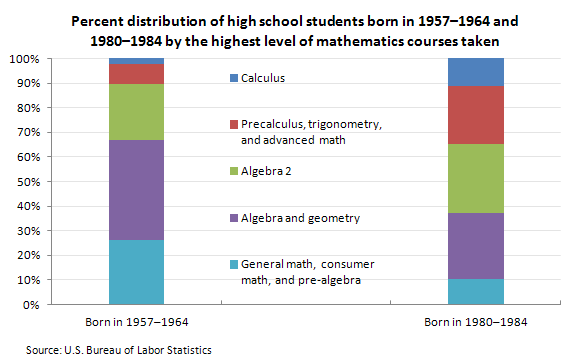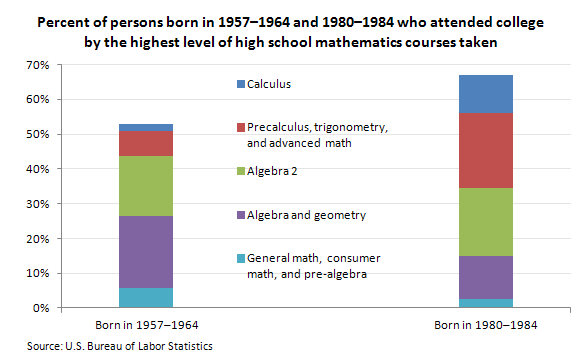October 16, 2012 (The Editor’s Desk is updated each business day.)
High school math courses and college attendance in two generations
Students who graduated from high school in the late 1990s and early 2000s took more rigorous mathematics courses than those who graduated in the mid to late 1970s and early 1980s. Among the more recent graduates (who were born in the years 1980–1984), 11 percent completed high school calculus and 24 percent completed precalculus, trigonometry, or other advanced math. Among the earlier graduates (who were born in the years 1957–1964), just 2 percent completed high school calculus and 8 percent completed precalculus, trigonometry, or other advanced math.

[Chart data]
A more rigorous high school math curriculum is associated with a higher probability of attending college. This positive association grew stronger between the 1970s and 2000s. College attendance increased markedly during this period. (College attendance is defined here as having been enrolled in college by age 21.) The college enrollment rate increased from 53 percent among those born in 1957–1964 to 67 percent among those born in 1980–1984.

[Chart data]
Among the college students born in 1957–1964, more than 70 percent had completed one of the middle-level high school math curricula of algebra, geometry, or algebra 2. Fewer than 1 in 5 had completed an advanced high school math curriculum of calculus, precalculus, trigonometry, or other advanced math. Among the college students born in 1980–1984, nearly half took advanced high school math classes.
These data are from the National Longitudinal Surveys program. To learn more, see "A comparison of college attendance and high school coursework from two cohorts of youth" (HTML) (PDF), by Alison Aughinbaugh in Beyond the Numbers, volume 1, number 14, October 2012.
Related TED articles
Education and training |
Youth
For citation purposes, this TED article is archived at
www.bls.gov/opub/ted/2012/ted_20121016.htm
Of interest
Spotlight on Statistics: National Hispanic Heritage Month
In this Spotlight, we take a look at the Hispanic labor force—including labor force participation, employment and unemployment, educational attainment, geographic location, country of birth, earnings, consumer expenditures, time use, workplace injuries, and employment projections.
Read more »

